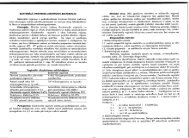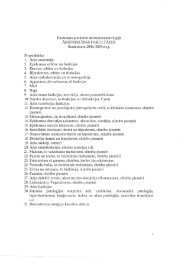PHYSICS
n - susliks.lv
n - susliks.lv
- No tags were found...
Create successful ePaper yourself
Turn your PDF publications into a flip-book with our unique Google optimized e-Paper software.
tri phosphate (ATP). A detailed descri ption of photosynthesis is<br />
not within the scope of this book. It is important to note that the<br />
absorbed energy can be released as heat or radiation such as<br />
fluorescence. Chlorophyll a fluorescence emission represents only a<br />
very small part (-2 - 5%) of the absorbed energy. The yield of<br />
chlorophyll fluorescence depends on number of complex factors.<br />
The relationshi p between in vivo chlorophyll fluorescence and<br />
photosynthetic activity in plants can be used to study the effect of<br />
various natural (e.g., high-intensity light, ultraviolet irradiation,<br />
heat, water shortage, mineral deficiency) and anthropogenic<br />
(e.g., agrochemical treatments, air pollutants, ozone, acid rains,<br />
heavy metals) stresses on plants.<br />
23.3.2. Phototropism<br />
Phototropism is a light mediated alteration in the pattern of<br />
plant growth due to a directional light stimulus. Growth toward a<br />
source of light is called positive phototropism; growth away from<br />
the source is termed negative phototropism. The tips of shoots<br />
normally exhibit a positive phototropic response while roots are<br />
negatively phototropic. There is considerable evidence that the<br />
change in growth rate causing the alteration in direction is<br />
controlled by a light induced differential in the concentration of<br />
the phytohormone auxin (indole-3-acetic acid) across the shoot.<br />
I.<br />
plants are controlled or influenced by photoperiod (e.g., the onset<br />
and breaking of bud dormancy in woody perennials, leaf abscission,<br />
rooting of cuttings, seed germination, bulb and tuber formation,<br />
development of frost resistance). Adults of the fruit fly Drosophila<br />
emerge from the pupa only during the hours near dawn. In humans,<br />
mental acuity varies with the time of day, as does body temperature,<br />
sleep, wakefulness, and hormone levels.<br />
23.3.4. Photomorphogenesis<br />
Photomorphogenesis is a non-directional growth, development,<br />
or differentiation process that is regulated by non-directional and<br />
non-periodic light stimuli. These include effects on seed germination,<br />
stem elongation, leaf expansion, chloroplast development,<br />
and the synthesis of chlorophyll. Typically, plants are<br />
responsive to wavelengths of light in the blue, red and far-red<br />
regions of the spectrum and are controlled through the action of<br />
several different photosensory systems. The photoreceptors for red<br />
and far-red wavelengths are known as phytochrome (from the<br />
Greek words for plant and color). Most plants have multiple phytochromes<br />
encoded by different genes. Cryptochromes are blue<br />
light receptors, two of which have been identified in plants.<br />
23.3.5. Photomovement<br />
23.3.3. Photoperiodism<br />
Photoperiodism is a mechanism by which certain developmental<br />
processes respond to a non-directional but periodic light stimulus.<br />
Most seasonable events are triggered by the duration or pattern of<br />
light/dark cycles. Maxima in various rate measurements continue to<br />
recur roughly every 24 hours under constant illumination. Since the<br />
period of the cycle was about (but not exactly) 24 hours, they are<br />
called circadian ("about a day") rhythms. For example, the marine<br />
dinoflagellate Gonyaulax polyedra emits bright flashes of light at<br />
night, while during the day it emits much less light. Photoperiod is<br />
used to signal seasonal changes in broad cross-section of plant<br />
species at which time the growing apices is transformed from a<br />
vegetative to a floral state. Various other developmental processes in<br />
Photomovement is any motile response or its alteration induced<br />
by light. The light-dependent behavior of freely motile organisms<br />
such as algae and protozoa includes various light-induced movements<br />
in space. The motility of organisms can be described using<br />
well-known physical parameters: velocity (V), direction (r) and<br />
trajectory (I). These parameters can be further subdivided to more<br />
precisely characterize types of movements by organisms. For<br />
example, velocity may be linear and angular. Both linear and<br />
angular velocities may be constant or vary as a function of time.<br />
Certain classes of linear or angular velocity may be divided<br />
according to specific velocity limits inherent to a particular organism.<br />
The light stimulus, in turn, is characterized by parameters<br />
such as intensity (I), direction (s), the spectral composition<br />
172 173






